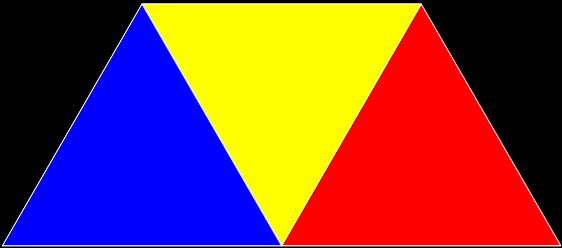
Construction of a Sierpiński tetrahedron (from WikiMedia)
Post-Performative Post-Scriptum
The toxic title of this incendiary intervention radically references George Harrison’s album Extra Texture (1975).


Construction of a Sierpiński tetrahedron (from WikiMedia)
Post-Performative Post-Scriptum
The toxic title of this incendiary intervention radically references George Harrison’s album Extra Texture (1975).
“Mathematics is the music of reason.” — James Joseph Sylvester (1814-97)
It’s a pretty little problem to convert this triangular fractal…
Sierpiński triangle (Wikipedia)
…into its circular equivalent:

Sierpiński triangle as circle
Sierpiński triangle to circle (animated)
But once you’ve circ’d it out, as it were, you can easily adapt the technique to fractals based on other polygons:
T-square fractal (Wikipedia)
⇓
T-square fractal as circle
T-square fractal to circle (animated)
Elsewhere other-accessible…
• Dilating the Delta — more on converting polygonic fractals to circles…
“In no other branch of mathematics is it so easy for experts to blunder as in probability theory.” — Martin Gardner (1914-2010)
It’s one of the most famous and easily recognizable logos in the world:
The Mitsubishi diamonds (source)
Those are the three diamonds of Mitsubishi, whose name itself means “three diamonds” or “three rhombi” in Japanese (see 三菱). But if you look at the Mitsubishi diamonds with a mathematical eye, you can see how to create them in two simple steps. First, you divide an equilateral triangle into nine smaller equilateral triangles. Then you discard three of the sub-triangles, like this:
Equilateral triangle divided into nine sub-triangles
↓
Six sub-triangles left after three are discarded
↓
But why stop there? Once you’ve discarded three triangles, six triangles are left. Now do the same to the remaining six: divide each into nine sub-triangles and discard three of the sub-triangles. Then do it again and again. When you’ve reduced the diamonds to dust, you’ve got a fractal, a shape that repeats itself at smaller and smaller scales:
Diamond fractal stage #1
Diamond fractal stage #2
Diamond fractal stage #3
Diamond fractal stage #4
Diamond fractal stage #5
Diamond fractal stage #6
Diamond fractal (animated)
After that, you can convert the fractal-within-a-triangle into a fractal-within-a-circle:
↓
Diamond fractal, triangular to circular (animated)
You can create other fractals by dividing-and-discarding sub-triangles from a rep-9 equilaterial triangle. Here’s what I call a rep9-tri grid fractal:
Grid fractal stage #1
Grid fractal stage #2
Grid fractal stage #3
Grid fractal stage #4
Grid fractal stage #5
Grid fractal stage #6
Grid fractal stage #7
Grid fractal (animated)
↓
Grid fractal, triangular to circular (animated)
And here’s a rep9-tri hexagon fractal:
Hexagon fractal (initial form)
Hexagon fractal stage #1
Hexagon fractal stage #2
Hexagon fractal stage #3
Hexagon fractal stage #4
Hexagon fractal stage #5
Hexagon fractal stage #6
Hexagon fractal (animated)
↓
Hexagon fractal, triangular to circular (animated)

Title page of Sir Henry Billingsley’s first English version of Euclid’s Elements, 1570, with personifications of Geometria, Astronomia, Arithmetica and Musica as beautiful young women
The title of this incendiary intervention is a paronomasia on “The Bells of Hell…”, a British airmen’s song in terms of core issues around World War I.
• 3, 7, 31, 127, 8191, 131071, 524287, 2147483647, 2305843009213693951, 618970019642690137449562111, 162259276829213363391578010288127, 170141183460469231731687303715884105727 — A000668, Mersenne primes (primes of the form 2^n – 1), at the Online Encyclopedia of Integer Sequences
• 2, 3, 5, 7, 13, 17, 19, 31, 61, 89, 107, 127, 521, 607, 1279, 2203, 2281, 3217, 4253, 4423, 9689, 9941, 11213, 19937, 21701, 23209, 44497, 86243, 110503, 132049, 216091, 756839, 859433, 1257787, 1398269, 2976221, 3021377, 6972593, 13466917, 20996011, 24036583, 25964951, 30402457, 32582657, 37156667, 42643801, 43112609, 57885161, 74207281, 77232917, 82589933 — A000043, Mersenne exponents: primes p such that 2^p – 1 is prime. Then 2^p – 1 is called a Mersenne prime. […] It is believed (but unproved) that this sequence is infinite. The data suggest that the number of terms up to exponent N is roughly K log N for some constant K.
• The largest known prime number (as of May 2022) is 282,589,933 − 1, a number which has 24,862,048 digits when written in base 10. It was found via a computer volunteered by Patrick Laroche of the Great Internet Mersenne Prime Search (GIMPS) in 2018. — Largest known prime number
An equilateral triangle is a rep-tile, because it can be tiled completely with smaller copies of itself. Here it is as a rep-4 rep-tile, tiled with four smaller copies of itself:
Equilateral triangle as rep-4 rep-tile
If you divide and discard one of the sub-copies, then carry on dividing-and-discarding with the sub-copies and sub-sub-copies and sub-sub-sub-copies, you get the fractal seen below. Alas, it’s not a very attractive or interesting fractal:

Divide-and-discard fractal stage #1
Stage #2
Stage #3
Stage #4
Stage #5
Stage #6
Stage #7
Stage #8
Stage #9
Divide-and-discard fractal (animated)
You can create more attractive and interesting fractals by rotating the sub-triangles clockwise or anticlockwise. Here are some examples:
Now try dividing a square into four right triangles, then turning each of the four triangles into a divide-and-discard fractal. The resulting four-fractal shape is variously called a swastika, a gammadion, a cross cramponnée, a Hakenkreuz and a fylfot. I’m calling it a fylfy fractal:
Divide-and-discard fractals in the four triangles of a divided square stage #1
Fylfy fractal #2
Fylfy fractal #3
Fylfy fractal #4
Fylfy fractal #5
Fylfy fractal #6
Fylfy fractal #7
Fylfy fractal #8
Fylfy fractal (animated)
Finally, you can adjust the fylfy fractals so that each point in the square becomes the equivalent point in a circle:

The Hourglass Fractal (animated gif optimized at ezGIF)
Performativizing Paronomasticity
The title of this incendiary intervention is a paronomasia on the title of the dire Absolutely Fabulous. The adjective sabulous means “sandy; consisting of or abounding in sand; arenaceous” (OED).
Elsewhere Other-Accessible
• Hour Re-Re-Re-Re-Powered — more on the hourglass fractal
• Allus Pour, Horic — an earlier paronomasia for the fractal